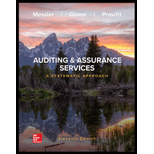
a.
Concept Introduction:
Audit samplingis the method of selecting few items to check from the entire population under examination. Auditors apply sampling method while performing their
To explain: The auditor’s justification for accepting the uncertainties that are inherent in the sampling process.
b.
Concept Introduction:
Audit sampling: sampling is the method of selecting few items to check from the entire population under examination. Auditors apply sampling method while performing their audit procedures. Sampling can be statistical or non statistical. When the auditor is performed test of control and substantive tests they used the statistical sampling technique that test the items less than 100% in the population with some characteristics and give the appropriate sampling risk.
To discuss: The uncertainties that express the concept of audit risk.
c.
Concept Introduction:
Audit sampling: sampling is the method of selecting few items to check from the entire population under examination. Auditors apply sampling method while performing their audit procedures. Sampling can be statistical or non statistical. When the auditor is performed test of control and substantive tests they used the statistical sampling technique that test the items less than 100% in the population with some characteristics and give the appropriate sampling risk.
To discuss: The nature of sampling risk and non-sampling risk include the effect of sampling risk on test of control
Want to see the full answer?
Check out a sample textbook solution
Chapter 8 Solutions
EBK AUDITING & ASSURANCE SERVICES: A SY
- calculate ratios for the financial statment given and show all working manually: 1. Debt Ratios 2. Debt to Equityarrow_forwardcalculate the following ratios for the statements and show all working: 1. Current Ratios 2. Quick Ratio 3. Cash Ratioarrow_forwardDont solve this question with incorrect values. i will give unhelpful . do not solvearrow_forward
- Jeff Krause purchased 1,000 shares of a speculative stock in January for $1.89 per share. Six months later, he sold them for $9.95 per share. He uses an online broker that charges him $10.00 per trade. What was Jeff's annualized HPR on this investment? Jeff's annualized HPR on this investment is %. (Round to the nearest whole percent.)arrow_forwardno ai do not answer this question if data is not clear or image is blurr. but do not amswer with unclear values. i will give unhelpful.arrow_forwardEstefan Industies has a new project available that requires an initial investment of sex million. The project will provide unlevered cash flows of $925,000 per year for the next 20 years. The company will finance the project with a debt-value ratio of 35. The company's bonds have a YTM of 5.9 percent. The companies with operations comparable to this project have unlevered betas of 1.09, 1.17, 1.28, and 1.20. The risk-free rate is 3.6 percent, and the market risk premium is 7 percent. The tax rate is 21 percent. What is the NPV of this project?arrow_forward
- no ai do not answer this question if data is not clear or image is blurr. please comment i will write values . but do not amswer with unclear values. i will give unhelpful.arrow_forwardno ai Image is blurr do not answer this question if data is not clear or image is blurr. please comment i will write values but do not amswer with unclear values. i will give unhelpful sure.arrow_forwardDon't solve this question with unclear data. i will give unhelpful rating . please skip this qnarrow_forward
 Auditing: A Risk Based-Approach (MindTap Course L...AccountingISBN:9781337619455Author:Karla M Johnstone, Audrey A. Gramling, Larry E. RittenbergPublisher:Cengage Learning
Auditing: A Risk Based-Approach (MindTap Course L...AccountingISBN:9781337619455Author:Karla M Johnstone, Audrey A. Gramling, Larry E. RittenbergPublisher:Cengage Learning Auditing: A Risk Based-Approach to Conducting a Q...AccountingISBN:9781305080577Author:Karla M Johnstone, Audrey A. Gramling, Larry E. RittenbergPublisher:South-Western College Pub
Auditing: A Risk Based-Approach to Conducting a Q...AccountingISBN:9781305080577Author:Karla M Johnstone, Audrey A. Gramling, Larry E. RittenbergPublisher:South-Western College Pub


